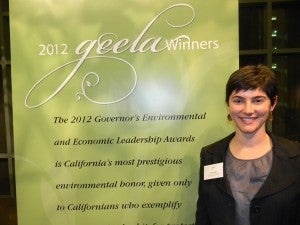Reprinted from Greenwire with permission from Environment & Energy Publishing, LLC. www.eenews.net. 202-628-6500
Laura Petersen, E&E reporter
Published: Wednesday, January 23, 2013
A loan program dedicated to helping West Coast fisheries become more sustainable earned California’s top environmental honor.
The California Fisheries Fund received the Governor’s Environmental and Economic Leadership Award, which recognizes individuals, organizations and businesses for finding innovative ways to protect natural resources while also strengthening the economy.
“It fits perfectly into the kind of themes the governor has chosen to promote,” said Jim Marxen, a spokesman for the California Environmental Protection Agency, which handed out 17 awards last night. “Good environmental practices and a healthy economy must live together, and really this project is an epitome of that.”
The $4 million fund, which began in 2008 with support from the state and foundations, provides loans to fishermen, processors and distributors to finance upgrades that result in more sustainable practices.For example, fisherman Steve Fitz recently received a loan to purchase his uncle’s boat and continue the family tradition of using Scottish seine fishing gear, which herds ground fish into light nets that are far gentler on the surrounding habitat and reduces bycatch of other marine life.
“Money isn’t that readily available to borrow in our industry,” said Fitz, who works in Half Moon Bay. “Having access to the fisheries fund … allowed it to become a reality. Here I am, a new vessel owner.”
The fund, which is administered by the Environmental Defense Fund, has distributed $1.7 million to 11 recipients to date.
As stocks declined and fishing seasons were shortened, some as low as two days a year, uncertainty skyrocketed for California fishermen — which makes banks unlikely to lend money.
“Lenders want to see predictable cash flow,” said Phoebe Higgins, director of the California Fisheries Fund.
The old management system threatened to shut down fishermen at any time — not so conducive to getting a loan, Higgins said.
That changed with catch shares.
The new system, which began for California groundfish in 2011, takes the total allowable catch and divides it among fishermen. Instead of trying to modulate catch by opening a fishery for a certain number of days or dictating the number of trips fishermen can take, the system lets fishermen know in advance how much they are allowed to catch. They can choose when to collect their dedicated quota, which allows them to spread out the inventory and negotiate better prices.
“Catch shares are the first type of fisheries management that offer that predictability,” Higgins said.
Greater confidence in the future is also helpful for fishermen, who are more willing to invest in gear that helps the environment and comply with the new regulations by reducing bycatch, Higgins said.
“Fishermen want to do the right thing, and when they have the tools to plan their business, they can definitely pull it off,” Higgins said, adding it often doesn’t take huge sums to implement a big change.
New Resource Bank, a San Francisco-based bank that lends only to companies striving to improve the sustainability of their businesses, partnered with the California Fisheries Fund on a loan for Wild Planet, an eco-friendly seafood processor and distributor.
“Lending to fishermen is a difficult business,” said Bill Peterson, the bank’s chief credit officer. “The problem is, we never know year to year what catch is going to look like, what conditions are going to be out there.”
But having a partner like the California Fisheries Fund helps reduce the risk and allows them to support the industry, he said.
Higgins said the fund has been “smooth sailing” with only one late payment in four years. She is hoping that as more fishermen become comfortable with the new catch-share program, they will seek out loans to finance positive changes.
She also hopes that it can serve as a model for financing transitions to more sustainable fisheries around the globe.
“We’ve been able to make this successful in our region,” Higgins said. “There’s no reason why it can’t be applied all over the world.”










